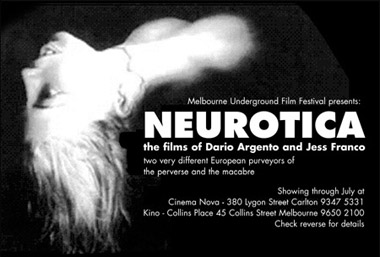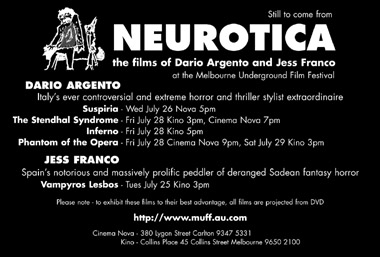

|
Section Three: "International Alternative Panorama" |
back to MUFF index |
| Curated by Chris Howard and Matt Boyle | more Neurotica |

|

|
|
To trace the trajectory of the career in film of the man early on his career dubbed "The Italian Hitchcock", Italy's ever controversial horror and thriller stylist extraordinaire Dario Argento, beloved of and of fascination to film buffs and academics alike we begin as the legend would have it with the child Dario a-perch upon the knee of Sophia Loren auspicious beginnings indeed! The son of movie producer Salvatore Argento, whose company Seda Spettacoli would come to produce his first six features, he worked in the late '60s as a critic for a Rome daily paper and wrote several filmed screenplays, including a collaboration with Bernardo Bertolucci on Sergio Leone's 1968 classic Once Upon a Time in the West. In 1970 he made his directorial debut with The Bird with the Crystal Plumage, a great success which sparked a huge glut of often similarly floridly titled "giallos", a peculiarly Italian variety of thriller in which determining whodunit is secondary to an often explicit foregrounding of the acts of murder and mayhem which inspire and propel these films' investigation of who's doing it and which reached its apotheoses in two Argento masterpieces, Deep Red in 1976 and Tenebre in 1982. In between, he crafted a wholly different sort of masterpiece, 1977's peerlessly surreal supernatural horror Suspiria. In 1979 he helped George Romero with his classic Dawn of the Dead; other notable films include Suspiria's sequel Inferno in 1980, the quite barmy Phenomena (aka Creepers) in 1985 and the very telling Opera in 1987. His actress daughter Asia has graced his last three films including the very dark The Stendhal Syndrome in 1996 and his latest, 1998's Phantom of the Opera. He is presently shooting his 15th feature I Can't Sleep, a giallo starring Max von Sydow, in Turin. His films are notable for their constant derangement of perspective over their characters' often fluid motivations and identity, with frequent recourse to point-of-view camera work often only serving to baffle viewer identification, such that it is often impossible to tell whether one is seeing through the eyes of the films' killers, their quarries or through some other agency altogether, until it's far too late to distance oneself as viewer from a sense of implication in the inevitable extreme and virtuoso murders that riddle his cinema - of note is the fact that it's typically the director's own hands wielding the murder weapons! He has readily admitted that he privileges an amazing visual over a mere matter of plotting, and that he conjures up his often astonishingly deviously staged murder scenes and the scenarios in which they are contained in a manner not unlike that of the surrealists with their automatic writing beyond this, he is ever coy when asked to explain himself and his movies, perhaps hoping that intelligent viewers should be able to glean all the insights he'd care to impart simply from viewing his sumptuous, startling and shocking films. CH |
Possibly the most prolific director of all time, Franco has over 150 films to his and his many pseudonyms' credit so many that even he admits that he can't remember them all. It comes as little surprise then that he has the dubious honour of having the most on Britain's official banned list. And there is little doubt that with so many of these being full of sex and horror, one might start to get a bit of a reputation. For there is certainly sex hardcore sex, softcore sex, fetishism, sadism, masochism and sado-masochism. And it his specific focus on the last few that has earned him his notoriety. And there is also horror often in combination with sex, or at least nudity. In the not atypical case of Vampyros Lesbos, three different versions were shot one with sex but without horror, one without sex but with horror and one with both, as similarly with 1973's notorious Female Vampire, aka The Barebreasted Countess and Erotikill, depending upon which version you're watching, featuring the creature of the title killing her victims during the act of fellatio after all, who says all vampires have to go for the neck? Yet it would be too quick to dismiss Franco out of hand for this alone. With a literary concern for Sade and Sacher von Masoch that goes beyond a mere quest for titillation, he explores the perverse undercurrents of human sexuality in the way the surrealists and various continental thinkers have from Simone de Beauvior to Michel Foucault and Gilles Deleuze. More general questions of cruelty, power and the nature of good and evil, they would have us believe, are explored at the margins of reason, not in the banalities of normal human conduct. As something like Succubus shows, not all bare flesh is mindless. Franco's relationship to theories of surrealism show clearly in this film, and an easy comparison to Buρuel can be made also in his more recent satirical work - although Fellini is another likely candidate. Franco's technical expertise is also often overlooked (his 'mastery' of the zoom is sometimes mentioned), but when a little time is taken to appreciate it, his use of cinematography and colour is often breathtaking. A little know fact is that he was called in as second unit director for Orson Welles' 1965 film Falstaff, aka Chimes at Midnight orchestrating the critically acclaimed battle sequences. There is much to appreciate and discover in Franco's massive oeuvre, much of which is often overlooked due to his unsavoury reputation. In a body of work so large there is a huge range in quality, thoughtfulness and subject matter. But there is undoubtedly much worth appreciating. Oh, yes. There is also sex, and there is horror. MB |